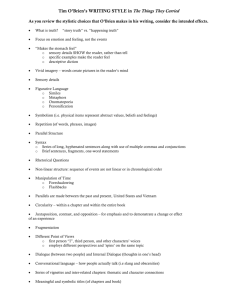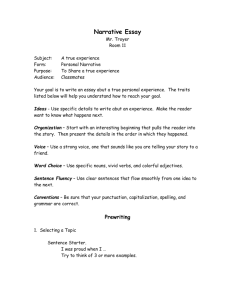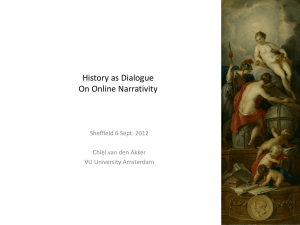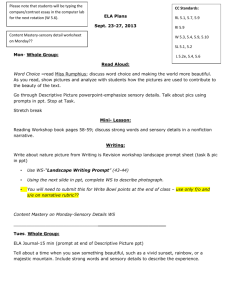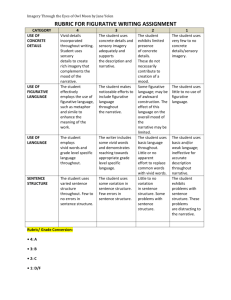Historical Narrative Rubric and Instructions
advertisement
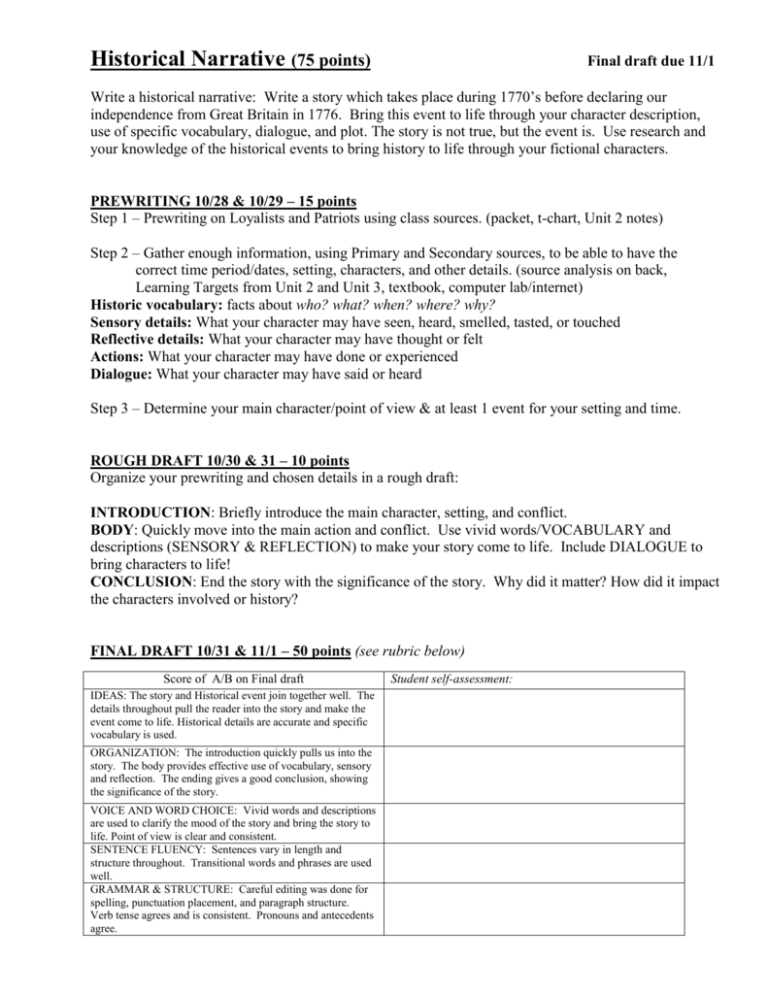
Historical Narrative (75 points) Final draft due 11/1 Write a historical narrative: Write a story which takes place during 1770’s before declaring our independence from Great Britain in 1776. Bring this event to life through your character description, use of specific vocabulary, dialogue, and plot. The story is not true, but the event is. Use research and your knowledge of the historical events to bring history to life through your fictional characters. PREWRITING 10/28 & 10/29 – 15 points Step 1 – Prewriting on Loyalists and Patriots using class sources. (packet, t-chart, Unit 2 notes) Step 2 – Gather enough information, using Primary and Secondary sources, to be able to have the correct time period/dates, setting, characters, and other details. (source analysis on back, Learning Targets from Unit 2 and Unit 3, textbook, computer lab/internet) Historic vocabulary: facts about who? what? when? where? why? Sensory details: What your character may have seen, heard, smelled, tasted, or touched Reflective details: What your character may have thought or felt Actions: What your character may have done or experienced Dialogue: What your character may have said or heard Step 3 – Determine your main character/point of view & at least 1 event for your setting and time. ROUGH DRAFT 10/30 & 31 – 10 points Organize your prewriting and chosen details in a rough draft: INTRODUCTION: Briefly introduce the main character, setting, and conflict. BODY: Quickly move into the main action and conflict. Use vivid words/VOCABULARY and descriptions (SENSORY & REFLECTION) to make your story come to life. Include DIALOGUE to bring characters to life! CONCLUSION: End the story with the significance of the story. Why did it matter? How did it impact the characters involved or history? FINAL DRAFT 10/31 & 11/1 – 50 points (see rubric below) Score of A/B on Final draft IDEAS: The story and Historical event join together well. The details throughout pull the reader into the story and make the event come to life. Historical details are accurate and specific vocabulary is used. ORGANIZATION: The introduction quickly pulls us into the story. The body provides effective use of vocabulary, sensory and reflection. The ending gives a good conclusion, showing the significance of the story. VOICE AND WORD CHOICE: Vivid words and descriptions are used to clarify the mood of the story and bring the story to life. Point of view is clear and consistent. SENTENCE FLUENCY: Sentences vary in length and structure throughout. Transitional words and phrases are used well. GRAMMAR & STRUCTURE: Careful editing was done for spelling, punctuation placement, and paragraph structure. Verb tense agrees and is consistent. Pronouns and antecedents agree. Student self-assessment: Primary Source Analysis for my Historical Narrative Source #1 title & author: _______________________________________________________________ Historic vocabulary: facts about who? what? when? where? why? Sensory details: What your character may have seen, heard, smelled, tasted, or touched Reflective details: What your character may have thought or felt Actions: What your character may have done or experienced Dialogue: What your character may have said or heard Source #2 title & author: _______________________________________________________________ Historic vocabulary: Sensory details: Reflective details: Actions: Dialogue: Source #3 title & author: _______________________________________________________________ Historic vocabulary: Sensory details: Reflective details: Actions: Dialogue: My narrative’s main character: _______________________________________________ My narrative’s historical event: _________________________________________________


